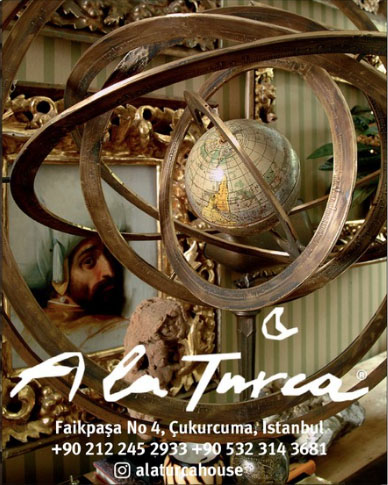Mussorgsky and Shostakovich were on the menu at a concert by the Istanbul State Symphony Orchestra on April 5. It was pleasing to see the auditorium at the Cemal Reşit Rey Concert Hall nearly full: classical music concerts in Istanbul are getting more and more popular by the year. Standards of performance are also going up, as I have previously remarked – but more of that anon.
This is the first time I have reviewed a concert by this orchestra in these columns, and I will begin by introducing it to the reader as an ensemble with distinguished antecedents. The origins of the Istanbul State Symphony Orchestra lie in the İstanbul Belediyesi Şehir Orkestrası (Istanbul Municipal City Orchestra), founded in 1945 and conducted in its early years by the composer Cemal Reşit Rey, photographed above with the diva Leyla Gencer (source: wannart). This orchestra, in turn, developed out of the Mızıka-ı Hümayun, the Musical Ensemble of the Ottoman Imperial Palace directed from 1828 to 1856 by Giuseppe Donizetti Pasha, elder brother of the opera composer Gaetano Donizetti.
Cemal Reşit Rey (1904–1985) was the son of the Governor of Jerusalem – which was then part of the Ottoman Empire. When he was five the family moved to Istanbul, where he began taking piano lessons. In 1913 they went to live to Paris, and here Poincaré, the French president, took a special interest in them. Gabriel Fauré, then director of the Paris Conservatoire, heard the young Cemal Reşit – by then a budding musician – play the piano, and immediately afterwards telephoned the celebrated teacher Marguerite Long to recommend him to her. With the outbreak of the First World War the Rey family moved to Geneva, where their son continued his musical training. In 1919 they returned to Istanbul, but soon afterwards the young pianist went back to Paris to study with Marguerite Long once again.
After graduating from the Paris Conservatoire in 1923, the 19-year-old Cemal Reşit gave up a promising career in Europe to teach at the newly opened Western Classical Music department of the İstanbul Belediyesi Darülelhan (the Municipal Conservatoire). There, he had a busy life teaching, founding and conducting orchestras, and composing – mostly operettas and musicals, but also more serious works such as the Onuncu Yıl Marşı (the Tenth Year March, written in 1933 for the tenth anniversary of the proclamation of the Turkish Republic). Today this march is probably better known in the jazzed-up version created by Kenan and Ozan Doğulu for the 75th anniversary celebrations in 1998, but anyway, here is a video of Cemal Reşit Rey himself telling the story of the work’s composition (in Turkish, of course) and playing the original version on the piano. This is followed by documentary footage of a ceremonial marchpast attended by Atatürk, with the March being sung in the background:
Like Cemal Reşit Rey, Hakan Şensoy (the Istanbul State Symphony Orchestra’s present conductor) is a very busy man. He is also the wielder of the baton for the Izmir State Symphony Orchestra, and a violin teacher to boot. My informants – wasps on the wall of the Ahmed Adnan Saygun Arts Centre that can on occasions be seen waving their antennae in time with the music – tell me that the Izmir orchestra is very much improved, though I have not attended any of their concerts myself. No doubt much of the credit for the progress achieved both in Istanbul and in Izmir is due to Mr Şensoy’s efforts, and for this he deserves much appreciation and gratitude.
The programme in Istanbul on April 5 began with Modest Mussorgsky’s orchestral poem Night on the Bare Mountain (1867) – a night punctuated by witchy scares. The version that is almost invariably played today is the handiwork of Nikolai Rimsky-Korsakov, who revised, re-orchestrated and very sensibly pruned it five years after Mussorgsky’s undignified death from alcoholism at the age of 42. (The two men once shared a small flat in St Petersburg; this was at the time when Mussorgsky was putting the finishing touches to his greatest work, the opera Boris Godunov. It was after Rimsky-Korsakov left their bachelor ménage to get married in 1872 that Mussorgsky began drinking to excess.) This description on the Classic FM website gives all the salient facts about Night on the Bare Mountain.
Here is a recording of the work in the Rimsky-Korsakov version. No details of the orchestra are available, unfortunately, but the performance is a spirited one. The conductor is Leonard Bernstein:
To see how expertly Rimsky-Korsakov ‘edited and abridged’ the work, adding more than a few touches of his own (especially to the orchestration), compare the previous video with the following one of Mussorgsky’s original version played by the London Philharmonic Orchestra, conducted by David Lloyd-Jones. The notes to this video (available on YouTube) have a summary of what Rimsky-Korsakov did to lick it into shape:
It was good to see that the Istanbul State Symphony Orchestra’s entries are less ragged than they used to be, and that their intonation is markedly better. Last time I listened to them (a few years ago), they were playing Beethoven’s Sixth Symphon. The oboist entirely missed his or her cue in the ‘Storm’ movement, and we were deprived of the most important oboe solo in the whole work. The time before that, their playing had been so inordinately dreadful that all I could do was squirm in my seat, grit my teeth and hope they would get through the piece (İlyas Mirzayev’s Third Symphony, the Istanbul) without a complete breakdown. Almost all f the orchestra’s members have changed in recent years, and the new guard are definitely an improvement on the old.
The second item on the programme was Shostakovich’s Piano Concerto No 2, composed in 1957 for the composer’s son Maxim, who played it at his graduation from the Moscow Conservatoire. Wicked rumours have reached my ear to the effect that the concerto’s chief pianistic ‘effect’ – the melodic line doubled at an interval of two octaves – was designed to allow Maxim to impress without placing undue strain on his somewhat shaky technique, but even so he had a hard time playing it. Anyway, in the end he became a conductor rather than a pianist, so no bones broken there.
Here are two critiques of the Shostakovich concerto. The first, by Anthony Suter on the Redlands Symphony website, is a straightforward, blow-by-blow guide to the work itself, while the second (by Paul Serotsky, from MusicWeb International) is worth it for the historical details, though I personally find the flights of fancy somewhat intrusive.
The soloist on April 5 was Antonio di Cristofano, who learned his art in Florence. The performance was a competent one, and very much appreciated by the audience, though I have to say that the pianist had a tendency to get ahead of the orchestra on occasions. My favourite among the various renditions available on YouTube is one by the Brazilian pianist Cristina Ortiz (by the way, it’s her birthday on April 17) and the Orchestra della Svizzera Italiana conducted by Rumon Gamba:
The second half of the concert was devoted to Mussorgsky’s Pictures at an Exhibition in the version orchestrated by Maurice Ravel in 1922 (the composer had originally written it as a piano solo). The Encyclopedia Britannica article gives you a basic run-down of the work.
The following recording of the orchestral version is by the Tokyo-based NHK Symphony Orchestra – energetically conducted by Valery Gergiev:
In the following three videos, the piano version is being played by Lazar Berman – one of my favourites, as you may know – to the visual accompaniment of the pictures by Viktor Hartmann (the composer’s artist friend who had died at the age of 39) that are likely to have inspired the work. The notes below the videos (available on YouTube) give you all the necessary details:
The Hartmann paintings are reproduced with greater clarity on this website.
The performance by the Istanbul State Symphony Orchestra on April 5 was not without its flaws, but this is a work in which there are a lot of time changes, and thus a host of opportunities for poorly co-ordinated entries. Also, pizzicato passages by the strings in the slower sections were not always in perfect synch. Having got these criticisms off my chest, I can safely say that this outfit is much improved from the last time I heard it several years ago, though it still has some way to go before it reaches the standard of the Tekfen and Borusan Orchestras. The trend is in the right direction, however, and with the increasing popularity of classical music in Turkey one hopes that discernment, and thus expectations, will also increase. It’s time to finger that Evil Eye bead and say ‘Maşallah’.












